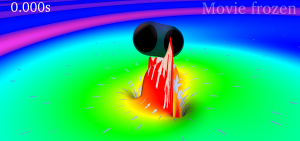On February 11th, 2016 (10:30AM EST), scientists from Caltech, MIT and the LIGO Scientific Collaboration together with representatives of the National Science Foundation, announced in a live press conference, the first direct detection of gravitational waves.
The event detected, named GW150914, was produced by two colliding black holes, inspariling and merging together. This signal was detected by LIGO on September 14th, 2015.
Details of this discovery can be found in the following papers:
- Observation of Gravitational Waves from a Binary Black Hole Merger (Phys. Rev. Lett. 116, 061102)
- The First Sounds of Merging Black Holes
- Summary of the detection
- Press Release
- Related papers to GW150914
- UofT News
Many of the researchers running simulations and analysing data in several of our clusters are directly involved in the efforts for accurately modelling, simulating and detecting gravitational wave signals.
As a matter of fact, one of the simulations used for visualizing one of the movies screened during the announcement of the discovery of gravitational waves, was performed on SciNet’s General Purpose Cluster (GPC).
“The first detection of gravitational waves passing through Earth is a tremendous discovery. These waves were generated by never before observed astronomical objects, colliding black holes. I am very grateful for SciNet and Compute Canada to provide the computing resources needed to explore the properties of binary black holes, research that was instrumental in building the waveform-templates that LIGO used in its momentous discovery.”
— Prof. Harald Pfeiffer (Canadian Institute for Theoretical Astrophysics, University of Toronto)





